| Gudea 𒅗𒌤𒀀 | |
|---|---|
| Ruler of Lagash | |
 Diorite statue of Gudea, prince of Lagash, dedicated to the god Ningishzida, Louvre Museum. | |
| Ruler of Lagash | |
| Reign | c. 2144–2124 BC |
| Predecessor | Ur-Baba |
| Successor | Ur-Ningirsu |
| Spouse | Ninalla |
| Issue | Ur-Ningirsu |
| Dynasty | Kings of Lagash |
Gudea (Sumerian: 𒅗𒌤𒀀, Gu3-de2-a) was a ruler (ensi) of the state of Lagash in Southern Mesopotamia, who ruled c. 2080–2060 BC (short chronology) or 2144–2124 BC (middle chronology). He probably did not come from the city, but had married Ninalla, daughter of the ruler Ur-Baba (2164–2144 BC) of Lagash, thus gaining entrance to the royal house of Lagash. He was succeeded by his son Ur-Ningirsu. Gudea ruled at a time when the center of Sumer was ruled by the Gutian dynasty, and when Ishtup-Ilum ruled to the north in Mari.[1] Under Gudea, Lagash had a golden age, and seemed to enjoy a high level of independence from the Gutians.[2]
Inscriptions
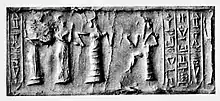
Gudea chose the title of énsi (town-king or governor), not the more exalted lugal (Akkadian šarrum). Gudea did not style himself "god of Lagash" as he was not deified during his own lifetime, this title must have been given to him posthumously[4] as in accordance with Mesopotamian traditions for all rulers except Naram-Sin of Akkad and some of the Ur III kings.[5]
The 20 years of his reign are all known by name; the main military exploit seems to have occurred in his Year 6, called the "Year when Anshan was smitten with weapons".[6]
Although Gudea claimed to have conquered Elam and Anshan, most of his inscriptions emphasize the building of irrigation channels and temples, and the creation of precious gifts to the gods.[7]
Materials for his buildings and statues were brought from all parts of western Asia: cedar wood from the Amanus mountains, quarried stones from Lebanon, copper from northern Arabia, gold and precious stones from the desert between Canaan and Egypt, diorite from Magan (Oman), and timber from Dilmun (Bahrain).[8][9][10]
Statues of Gudea
.JPG.webp)
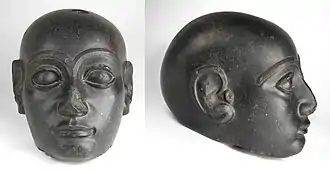
Religion




The inscription on a statue of Gudea as architect of the House of Ningirsu,[11] warns the reader of doom if the words are altered, but there is a startling difference between the warnings of Sargon or his line and the warnings of Gudea. The one is length; Gudea's curse lasts nearly a quarter of the inscription's considerable length,[12] and another is creativity. The gods will not merely reduce the offender's progeny to ash and destroy his foundations, no, they will, "let him sit down in the dust instead of on the seat they set up for him". He will be "slaughtered like a bull… seized like an aurochs by his fierce horn".[13]
Lagash under Gudea had extensive commercial communications with distant realms. According to his own records, Gudea brought cedars from the Amanus and Lebanon mountains in Syria, diorite from eastern Arabia, copper and gold from central and southern Arabia and from Sinai, while his armies were engaged in battles in Elam on the east.[14]
International relations

In an inscription, Gudea referred to the Meluhhans who came to Sumer to sell gold dust, carnelian etc...[14] In another inscription, he mentioned his victory over the territories of Magan, Meluhha, Elam and Amurru.[14]
In the Gudea cylinders, Gudea mentions that "I will spread in the world respect for my Temple, under my name the whole universe will gather in it, and Magan and Meluhha will come down from their mountains to attend" (cylinder A, IX).[15] In cylinder B, XIV, he mentions his procurement of "blocks of lapis lazuli and bright carnelian from Meluhha."[16]
The first known reference to Goa in India possibly appears as Gubi in the records of Gudea.[17] At the time, Sumerians had established trade contacts with India.[17]
Important artifacts
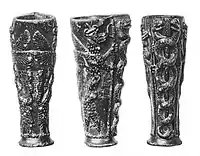 The "Libation vase of Gudea" with the dragon Mušḫuššu, dedicated to Ningishzida (21st century BC short chronology). The caduceus (right) is interpreted as depicting god Ningishzida. Inscription; "To the god Ningiszida, his god, Gudea, Ensi (governor) of Lagash, for the prolongation of his life, has dedicated this"
The "Libation vase of Gudea" with the dragon Mušḫuššu, dedicated to Ningishzida (21st century BC short chronology). The caduceus (right) is interpreted as depicting god Ningishzida. Inscription; "To the god Ningiszida, his god, Gudea, Ensi (governor) of Lagash, for the prolongation of his life, has dedicated this"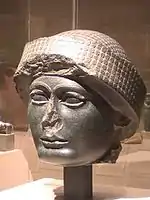 Head of Gudea in polished diorite, reign of Gudea (Boston Museum of Fine Arts).
Head of Gudea in polished diorite, reign of Gudea (Boston Museum of Fine Arts).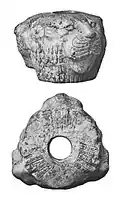 Lion macehead of Gudea, Girsu.[18]
Lion macehead of Gudea, Girsu.[18]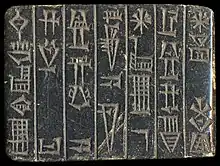
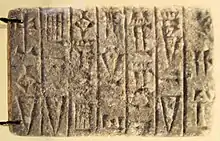 Gudea tablet: "For Hendursaga, his master, Gudea, ruler of Lagash, built his house."[19] Vorderasiatisches Museum, Berlin
Gudea tablet: "For Hendursaga, his master, Gudea, ruler of Lagash, built his house."[19] Vorderasiatisches Museum, Berlin Foundation nail of Gudea, Cleveland Museum of Art
Foundation nail of Gudea, Cleveland Museum of Art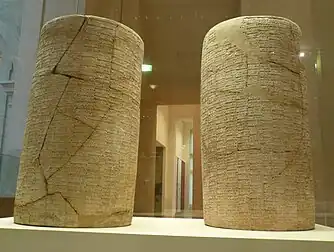 The Gudea cylinders.[20]
The Gudea cylinders.[20] Name and title "Gudea, ensi of Lagash" on Statue A of Gudea.
Name and title "Gudea, ensi of Lagash" on Statue A of Gudea. Foundation nail for the temple of Ningirsu in Lagash. Reign of Gudea.
Foundation nail for the temple of Ningirsu in Lagash. Reign of Gudea. Mudbrick stamped with a cuneiform text mentioning the name of Gudea, ruler of Lagash. From Girsu, Iraq, c. 2115 BCE. Vorderasiatisches Museum, Berlin
Mudbrick stamped with a cuneiform text mentioning the name of Gudea, ruler of Lagash. From Girsu, Iraq, c. 2115 BCE. Vorderasiatisches Museum, Berlin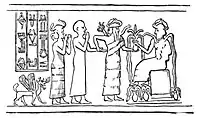 Seal of Gudea, led by Ningishzida.
Seal of Gudea, led by Ningishzida.
References
- ↑ Durand, M.L. (2008). Supplément au Dictionnaire de la Bible: TELL HARIRI/MARI: TEXTES (PDF). p. 227.
- ↑ Corporation, Marshall Cavendish (2010). Ancient Egypt and the Near East: An Illustrated History. Marshall Cavendish. pp. 54–56. ISBN 978-0-7614-7934-5.
- ↑ Ward, W. H. (1910). The seal cylinders of western Asia. Рипол Классик. pp. 23–24 Note 13, Seal N.38. ISBN 9785878502252.
- ↑ Edzard (1997), p. 26.
- ↑ Brisch, Nicole (2013). "Of Gods and Kings: Divine Kingship in Ancient Mesopotamia". Religion Compass. 7 (2): 37–46. doi:10.1111/rec3.12031.
- ↑ Year-names for Gudea, Cuneiform Digital Library Initiative.
- ↑ Steinkeller, Piotr. Puzur-Inˇsuˇsinak at Susa: A Pivotal Episode of Early Elamite History Reconsidered. p. 299.
- ↑ Thomason, Allison Karmel (2017). Luxury and Legitimation: Royal Collecting in Ancient Mesopotamia. Routledge. p. 87. ISBN 978-1-351-92113-8.
- ↑ Moorey, Peter Roger Stuart (1999). Ancient Mesopotamian Materials and Industries: The Archaeological Evidence. Eisenbrauns. p. 245. ISBN 978-1-57506-042-2.
- ↑ Thapar, Romila (1975). "A Possible Identification of Meluḫḫa, Dilmun and Makan". Journal of the Economic and Social History of the Orient. 18 (1): 1–42. doi:10.2307/3632219. ISSN 0022-4995. JSTOR 3632219.
- ↑ Edzard (1997), pp. 31–38.
- ↑ Edzard (1997), pp. 36–38.
- ↑ Edzard (1997), p. 38.
- 1 2 3 "MS 2814 - The Schoyen Collection". www.schoyencollection.com.
- ↑ "J'étendrai sur le monde le respect de mon temple, sous mon nom l'univers depuis l'horizon s'y rassemblera, et [même les pays lointains] Magan et Meluhha, sortant de leurs montagnes, y descendront" (cylindre A, IX)" in "Louvre Museum".
- ↑ Moorey, Peter Roger Stuart (1999). Ancient Mesopotamian Materials and Industries: The Archaeological Evidence. Eisenbrauns. p. 87. ISBN 978-1-57506-042-2.
- 1 2 Souza, Teotonio R. De (1990). Goa Through the Ages: An economic history. Concept Publishing Company. p. 2. ISBN 978-81-7022-259-0.
- ↑ de Sarzec, Ernest. Découvertes en Chaldée. L. Heuzey. p. 229.
- ↑ D. O. Edzard, The Royal inscriptions of Mesopotamia, Early periods, vol. 3/1, Gudea and His Dynasty, Toronto, 1997, p. 117-118
- ↑ "Louvre Museum".
Sources
- Edzard, Dietz-Otto (1997). Gudea and His Dynasty. University of Toronto Press. ISBN 9780802041876.
- Black, J.A.; Cunningham, G.; Dahl, Jacob L.; Fluckiger-Hawker, E.; Robson, E.; Zólyomi, G. (1998). "The Electronic Text Corpus of Sumerian Literature". University of Oxford.
- Frayne, Douglas R. (1993). Sargonic and Gutian Periods. University of Toronto Press.
- F. Johansen, "Statues of Gudea, ancient and modern". Mesopotamia 6, 1978.
- A. Parrot, Tello, vingt campagnes des fouilles (1877-1933). (Paris 1948).
- N.K. Sandars, "Introduction" page 16, The Epic of Gilgamesh, Penguin, 1972.
- H. Steible, "Versuch einer Chronologie der Statuen des Gudea von Lagas". Mitteilungen der Deutschen Orient-Gesellschaft 126 (1994), 81–104.
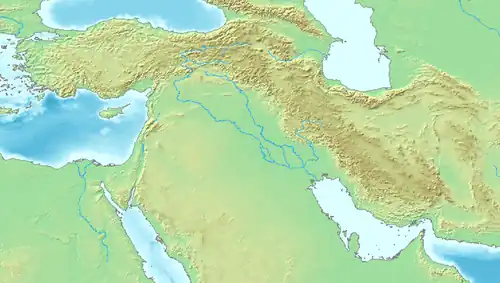
.jpg.webp)
